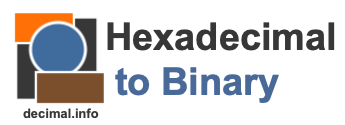
Here we will show you how to convert the hexadecimal number 9F17 to a binary number. First note that the hexadecimal number system has sixteen different digits (0 1 2 3 4 5 6 7 8 9 A B C D E F) and the binary number system has only two different digits (0 and 1).
The four steps used to convert 9F17 from hexadecimal to binary are explained below.
Step 1)
Multiply the last digit in 9F17 by 16⁰, multiply the second to last digit in 9F17 by 16¹, multiply the third to last digit in 9F17 by 16², multiply the fourth to last digit in 9F17 by 16³, and so on, until all the digits are used.
7 × 16⁰ = 7
1 × 16¹ = 16
F × 16² = 3840
9 × 16³ = 36864
Remember that the hexadecimal number system has sixteen different digits, so when doing the above calculation, we use the following values if applicable: A=10, B=11, C=12, D=13, E=14, and F=15.
Step 2)
Next, we add up all the products we got from Step 1, like this:
7 + 16 + 3840 + 36864 = 40727
Step 3)
Now we divide the sum from Step 2 by 2. Put the remainder aside. Then divide the whole part by 2 again, and put the remainder aside again. Keep doing this until the whole part is 0.
40727 ÷ 2 = 20363 with 1 remainder
20363 ÷ 2 = 10181 with 1 remainder
10181 ÷ 2 = 5090 with 1 remainder
5090 ÷ 2 = 2545 with 0 remainder
2545 ÷ 2 = 1272 with 1 remainder
1272 ÷ 2 = 636 with 0 remainder
636 ÷ 2 = 318 with 0 remainder
318 ÷ 2 = 159 with 0 remainder
159 ÷ 2 = 79 with 1 remainder
79 ÷ 2 = 39 with 1 remainder
39 ÷ 2 = 19 with 1 remainder
19 ÷ 2 = 9 with 1 remainder
9 ÷ 2 = 4 with 1 remainder
4 ÷ 2 = 2 with 0 remainder
2 ÷ 2 = 1 with 0 remainder
1 ÷ 2 = 0 with 1 remainder
Step 4)
In the final step, we take the remainders from Step 3 and put them together in reverse order to get our answer to 9F17 hexadecimal to binary:
9F17 hexadecimal = 1001111100010111 binary
Hexadecimal to Binary Converter
Here you can convert another hexadecimal number to binary.
9F18 hexadecimal to binary
Go here for the next hexadecimal number on our list that we have converted to binary.
Copyright | Privacy Policy | Disclaimer | Contact
